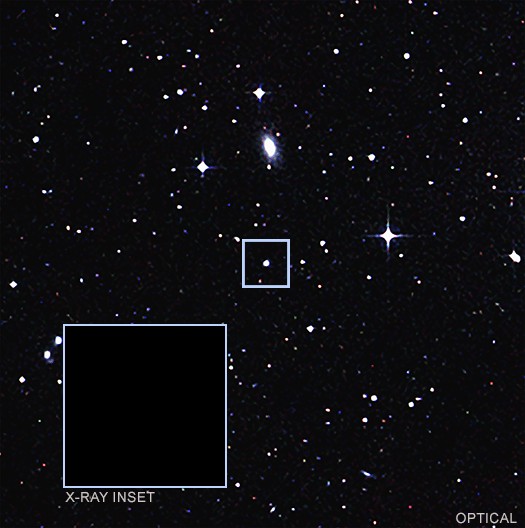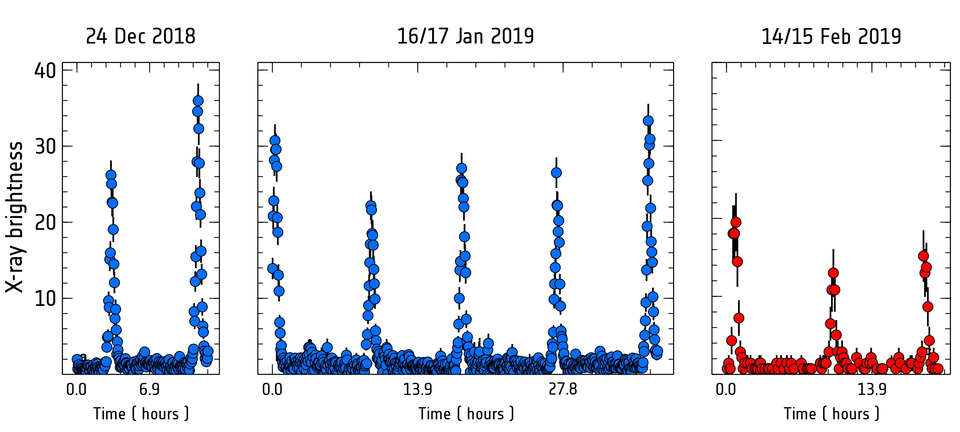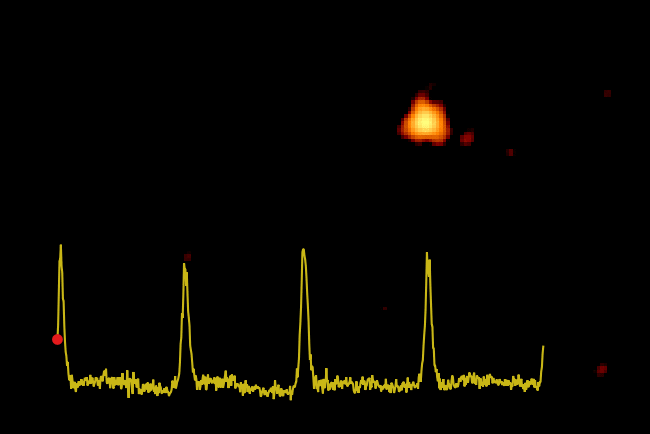Unexpected periodic flares may shed light on black hole accretion
ESA’s X-ray space telescope XMM-Newton has detected never-before-seen periodic flares of X-ray radiation coming from a distant galaxy that could help explain some enigmatic behaviours of active black holes.
XMM-Newton, the most powerful X-ray observatory, discovered some mysterious flashes from the active black hole at the core of the galaxy GSN 069, about 250 million light years away. On 24 December 2018, the source was seen to suddenly increase its brightness by up to a factor 100, then dimmed back to its normal levels within one hour and lit up again nine hours later.
“It was completely unexpected,” says Giovanni Miniutti, of the Centro de Astrobiología in Madrid, Spain, lead author of a new paper published in the journal Nature today.
“Giant black holes regularly flicker like a candle but the rapid, repeating changes seen in GSN 069 from December onwards are something completely new.”
Further observations, performed with XMM-Newton as well as NASA’s Chandra X-ray observatory in the following couple of months, confirmed that the distant black hole was still keeping the tempo, emitting nearly periodic bursts of X-rays every nine hours. The researchers are calling the new phenomenon ‘quasi-periodic eruptions’, or QPEs.

“The X-ray emission comes from material that is being accreted into the black hole and heats up in the process,” explains Giovanni.
“There are various mechanisms in the accretion disc that could give rise to this type of quasi-periodic signal, potentially linked to instabilities in the accretion flow close to the central black hole.
“Alternatively, the eruptions could be due to the interaction of the disc material with a second body – another black hole or perhaps the remnant of a star previously disrupted by the black hole.”
Although never before observed, Giovanni and colleagues think periodic flares like these might actually be quite common in the Universe.
It is possible that the phenomenon had not been identified before because most black holes at the cores of distant galaxies, with masses millions to billions of times the mass of our Sun, are much larger than the one in GSN 069, which is only about 400 000 times more massive than our Sun.
The bigger and more massive the black hole, the slower the fluctuations in brightness it can display, so a typical supermassive black hole would erupt not every nine hours, but every few months or years. This would make detection unlikely as observations rarely span such long periods of time.
And there is more. Quasi-periodic eruptions like those found in GSN 069 could provide a natural framework to interpret some puzzling patterns observed in a significant fraction of active black holes, whose brightness seems to vary too fast to be easily explained by current theoretical models.
“We know of many massive black holes whose brightness rises or decays by very large factors within days or months, while we would expect them to vary at a much slower pace,” says Giovanni.
“But if some of this variability corresponds to the rise or decay phases of eruptions similar to those discovered in GSN 069, then the fast variability of these systems, which appears currently unfeasible, could naturally be accounted for. New data and further studies will tell if this analogy really holds.”

The quasi-periodic eruptions spotted in GSN 069 could also explain another intriguing property observed in the X-ray emission from nearly all bright, accreting supermassive black holes: the so-called ‘soft excess’.
It consists in enhanced emission at low X-ray energies, and there is still no consensus on what causes it, with one leading theory invoking a cloud of electrons heated up near the accretion disc.
Like similar black holes, GSN 069 exhibits such a soft X-ray excess during bursts, but not between eruptions.
“We may be witnessing the formation of the soft excess in real time, which could shed light on its physical origin,” says co-author Richard Saxton from the XMM-Newton operation team at ESA’s astronomy centre in Spain.
“How the cloud of electrons is created is currently unclear, but we are trying to identify the mechanism by studying the changes in the X-ray spectrum of GSN 069 during the eruptions.”
The team is already trying to pinpoint the defining properties of GSN 069 at the time when the periodic eruptions were first detected to look for more cases to study.
"One of our immediate goals is to search for X-ray quasi-periodic eruptions in other galaxies, to further understand the physical origin of this new phenomenon,” adds co-author Margherita Giustini of Madrid’s Centro de Astrobiología.
“GSN 069 is an extremely fascinating source, with the potential to become a reference in the field of black hole accretion,” says Norbert Schartel, ESA’s XMM-Newton project scientist.
The discovery would not have been possible without XMM-Newton’s capabilities.
“These bursts happen in the low energy part of the X-ray band, where XMM-Newton is unbeatable. We will certainly need to use the observatory again if we want to find more of these kinds of events in the future,” concludes Norbert.
Notes for editors
‘Nine-hour X-ray quasi-periodic eruptions from a low-mass black hole galactic nucleus’ by G. Miniutti et al. is published in Nature. DOI: 10.1038/s41586-019-1556-x
The international research team used astronomical data from ESA’s XMM-Newton, NASA’s Chandra and Swift X-ray observatories, the NASA/ESA Hubble Space Telescope, NRAO’s Karl G. Jansky Very Large Array in New Mexico, USA, CSIRO’s Australia Telescope Compact Array in Australia, and SARAO’s MeerKAT radio telescope in South Africa.
More on this discovery on Nature’s blog
For more information, please contact:
Giovanni Miniutti
Centro de Astrobiología (CAB, CSIC-INTA)
Madrid, Spain
Email: gminiutti@cab.inta-csic.es
Richard Saxton
Telespazio-Vega UK for ESA
XMM-Newton Science Operations Centre
European Space Agency
Email: richard.saxton@sciops.esa.int
Margherita Giustini
Centro de Astrobiología (CAB, CSIC-INTA)
Madrid, Spain
Email: mgiustini@cab.inta-csic.es
Norbert Schartel
XMM-Newton project scientist
European Space Agency
Email: norbert.schartel@sciops.esa.int




